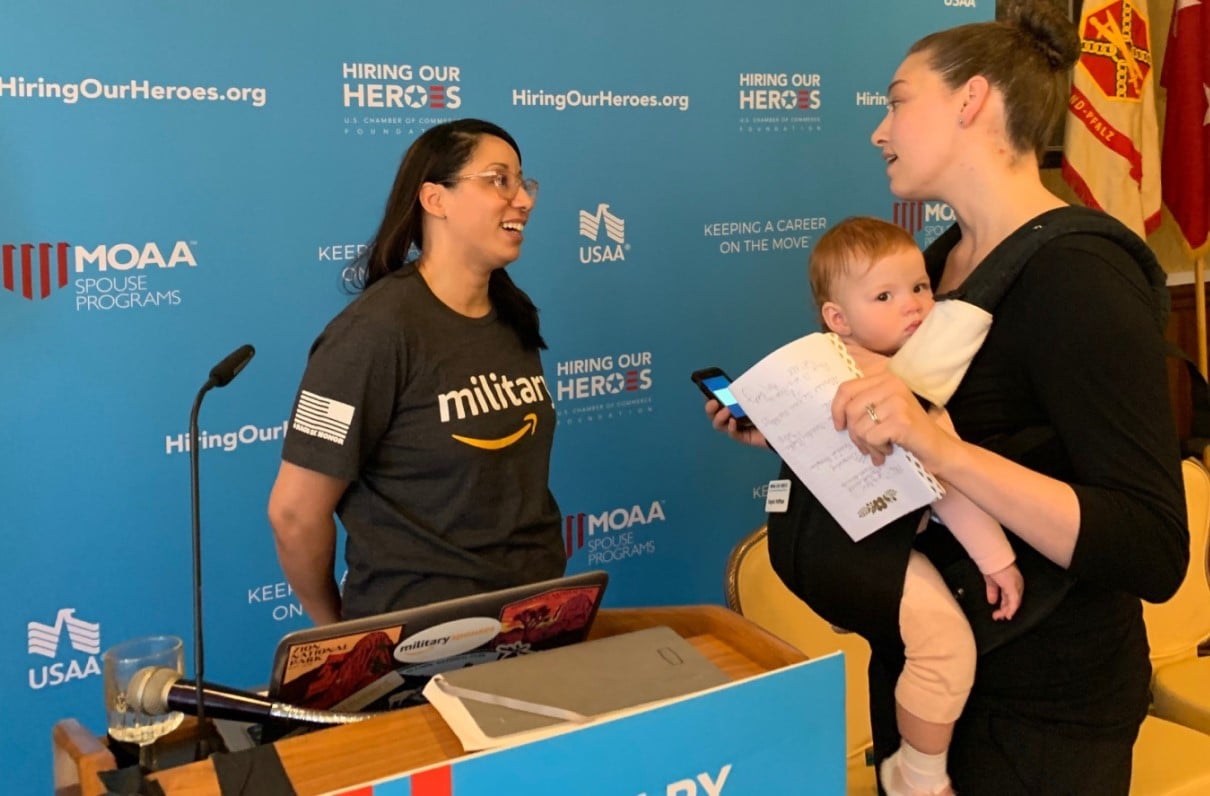MOAA is leading by example in its ongoing fight to preserve the all-volunteer force by providing professional opportunities to military spouses. More than 15% of MOAA’s staff members – 13 of 84 employees – are spouses of currently serving, veteran, or retired servicemembers, or are surviving spouses.
MOAA recently joined the 4+1 Commitment, a nationwide program led by Blue Star Families and Hiring Our Heroes. Participants commit to at least one of the following ways to assist military spouses:
- Facilitate job transferability
- Offer remote or telework
- Offer flexible work hours
- Provide paid PCS leave
MOAA is also a partner in the DoD-led Military Spouse Employment Partnership; joining a government spouse employment program is the “+1” part of the commitment.
“MOAA understands the importance of leading by example,” said Lt. Gen. Brian T. Kelly, USAF (Ret), MOAA’s president and CEO. “We benefit greatly from the skills and experience brought to our organization by military spouses, and we hope to encourage other employers to tap this unheralded resource. Not only is it a key part of how we do business, it’s a critical advocacy mission and a keystone to the health of the all-volunteer force.”
[DOWNLOAD: MOAA’s Military Spouse Employment Guide]
Other 4+1 Commitment members include the VA, Starbucks, USAA, Comcast, and Johnson & Johnson. Find more participants and learn more about the program at this link.
Fighting Spouse Unemployment
There are troves of data detailing the challenges military spouses face when it comes to finding gainful employment, and considerable effort and funding has gone into developing programs to address this issue in both federal and corporate sectors. And yet, for over a decade, the spouse unemployment rate hasn’t dipped below 20%.
Rather than continuing to study the causes of military spouse unemployment, it’s time to address three main components of the issue:
- The need for better, more timely data.
- Identifying efforts not effectively solving the problem yet sucking up valuable resources.
- Going beyond “encouragement.”
[RELATED: ‘Encouragement’ Won’t Solve the Military Spouse Employment Crisis]
Accurate, Real-Time Data Collection
DoD relies on biannual spouse surveys (one for active duty and another for the reserve component) to gather data on spouse employment. While useful, these surveys fail to track spouse employment in real time, resulting in outdated information.
The Bureau of Labor Statistics (BLS) tracks several demographic categories, including adult men and women, teenagers, race, veteran status, and long-term unemployed. There’s an opportunity to use existing databases to track spousal employment more accurately by requiring BLS, DoD, and the U.S. Census Bureau to work together and include corresponding data in the monthly employment situation report.
Alternatively, DoD could use the existing Defense Enrollment Eligibility Reporting System (DEERS) to track spouse employment, as all military dependents are required to be enrolled in DEERS to receive an ID card and access military-related benefits.
[RELATED: MOAA’s To-Do List for the FY 2025 NDAA]
Figure Out What Works
In a 1990 study on Army spouse employment, researchers highlighted the lack of impact on-base employment centers had on addressing military spouse unemployment, noting that the presence of such programs “did not significantly influence employment rates (76% versus 77% at posts with and without programs, respectively).”
The report went as far as noting that of the small number of spouses who accessed the Family Member Employment Assistance Programs (FMEAP), less than half found the resources helpful. Yet, more than 30 years later, FMEAPs still can be found at nearly every installation.
If the service branches are dead-set on maintaining this resource for families, they must be required to provide metrics (usage rates, employment offers, etc.) that support continued funding. Identifying programs that aren’t helping will allow DoD to redirect valuable funding to programs like the Military Spouse Career Accelerator Pilot that have seen resounding success.
Stop Encouraging, Start Directing
Three separate administrations have used executive orders to call for improvements to federal hiring practices to provide employment opportunities to military spouses, yet legislation to incentivize military spouse hiring in the private sector has been repeatedly introduced and not passed by Congress since 2005. And status of forces agreements in many countries still severely restrict work opportunities for currently serving spouses.
Encouraging companies and federal agencies to “do the right thing” and hire a military spouse simply isn’t working. Policies must clearly direct or incentivize military spouse hiring.
[TAKE ACTION: Urge Lawmakers to Support Retention of Federally-Employed Military Spouses]
Military spouse un- and underemployment continues to be a top reason why those in uniform leave service. Visit MOAA’s Legislative Action Center to learn how you can make a difference on this issue and other MOAA priorities.
Support Military Spouses
Donate to The MOAA Foundation and support MOAA’s efforts to help military spouses in their career journeys.

